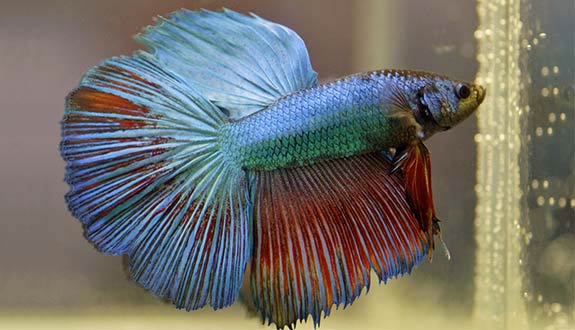

Alternative species (click on the thumbnail to see the card)
Names
Scientific name
Betta splendens
Micracanthus marchei
Betta splendens abbreviata
Common name
Siamese fighting fish
Origin

Origin: Thailand, Laos, India, Cambodge
Biotope: Asian
Dimorphism

Females are generally duller and have short fins. Its genital papilla is white. (Note that some males may also have these characteristics)
Group

Osphronemidae
Volume

20 L / 4 imp gal / 5 US gal
Parameters

T°: 23 to 25°C or 73 to 77°F
pH: 6.5 à 7.5
Hardness: 10 à 15°dGH
Difficulty

Average
Size

5.5 to 7cm (2 to 2.7")
Longevity

2 to 6 years
Living zone
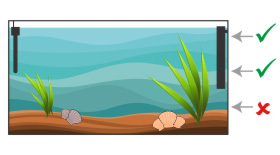
Middle and top
Individuals
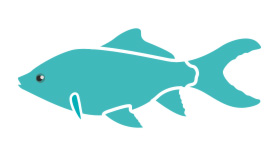
1
Food
How to feed the Betta?
Food
How to feed the Betta?
It is a carnivorous species. Beware, the fighting fish does not digest the «classic» glitter. You must therefore provide it a specific and adapted food: dry foods specially designed for them (in granules preferably) can be a base but that you will complete with preys (frozen, freeze-dried or even better: alive!)
2 times a week maximum (fatty and heavy foods): bloodworms, artemia, tubifex
More regularly: daphnia, mosquito larvae, Asellus aquaticus (foods that do not cause obesity or digestive problems).
Note that the red Daphnia can improve the colour of your fish.
Behavior
What kind of behavior does the Betta have?
Behavior
What kind of behavior does the Betta have?
In a suitable aquarium, the Betta is quite active and very curious.
Males are extremely aggressive to each other (which have earned them the name of «fighter»). If they are in the presence of other males, the Fighter will fight until the death of its opponents, or its own! Moreover, sometimes the winner ends up dying of exhaustion. Before fighting, they will deploy their fins to intimidate their opponent. In the fight, they completely tear the fins.
To make it look menacing, just show it its reflection in a mirror and it will then be in «fighter» mode. So, avoid installing your aquarium in front of a mirror. Note that this hyper aggressiveness is not at all natural and is specific to farmed fish. Indeed, before becoming ornamental fish, they were raised to make bets in Asia, like the cock fights in other regions (practice still relevant unfortunately). That is why we have long maintained and encouraged this aggressiveness that is now found in all breeding specimens.
Cohabitation
Who can live with the Betta?
Cohabitation
Who can live with the Betta?
The males between them do not get along at all, and never associate two males in the same aquarium, because the weakest will inevitably die. The cohabitation between females is feasible but remains quite delicate (plan a group of at least 6 individuals for the hierarchy to be stable). The success of these cohabitations will depend a lot on the environment (scenery, vegetation, hiding places, number of individuals, volume...) and the temper of the fish.
Regarding cohabitation with shrimps and snails, it remains very uncertain. Better not to risk it!
It is therefore more prudent not to have the Betta splendens coexist with any other fish, and to provide a nice nano-aquarium in which it will be the only occupant.
Note that it has been observed that young fish can sometimes accept other species in their tank, but they become very aggressive in adulthood.
Breeding
How to breed the Betta?
Breeding
How to breed the Betta?
You must have several aquariums if you want to breed this species. Indeed, the male and the female must meet only for breeding: you will need 1 cuve for breeding, 1 cuve for the maintenance of the male and 1 for the female. In addition, the fry must be separated from each other by the age of 3 months (cohabitation possible up to 7 months, but with some losses). For example, you can build a large aquarium in compartments. You must be prepared, from a material point of view, before attempting to breed the Betta Splendens.
Your breeding fish should be quite young, ideally between 6 and 12 months old. Prepare the pair by feeding them with live and varied prey (at least once every two days).
For the breeding tank, choose a small aquarium of 20 to 40 liters (4 to 9 imp gal or 5 to 10 US gal) that you will develop as a «classic» aquarium for Betta: soil and a lot of vegetation. Install a lot of hiding places and some floating plants like Ceratophyllum demersum for example. Let this aquarium turn so that it stabilizes and a population of paramecies (first fry food) takes up residence. Make sure that there is no movement on the surface and that the suction strainer of the filter is protected so that the future fry do not get sucked. Better results are obtained with the following water parameters: temperature at 28°C (82°F), pH at 6 and hardness at 8°dGH.
This tank must be partitioned: one for the male and another for the female. The fish must be able to see each other without touching each other. The partition will still exchange the pheromones necessary to trigger the spawning. Therefore it should let water pass between the 2 parts of the aquarium. Another alternative: put in the aquarium a plastic bottle, cut the top, and perforated with small holes in which you put the female later. However, this method is more stressful for the female.
Introduce the male into this breeding aquarium and let it get used to this new environment (2 or 3 days). Then introduce the female into the bottle: the male can see it but not touch it (you can also separate the breeding tank in two parts with a plastic mesh). The male should then begin to build a bubble nest on the surface, between the floating plants. This nest is very fragile so there must be no movement of water that could damage or destroy it.
After 2 or 3 days, observe the female: its belly must be bounced. It is also often observed that it is positioned with the head down. Last point to check: if it has horizontal bands, they must have left room for vertical bands. If you see these signs, you can release the female and put it in contact with the male. If you do not check these points, the female may not be ready to breed, and if you release it in the bin with the male, it will be a carnage! So be careful during this step and make sure that the female is mature.
After the introduction of the female, the male will pursue it through the entire aquarium to eventually end up directing it towards the bubble nest. If the relation between the two individuals is going well, you can leave them maximum 3 days together to try the spawning (if the male does not abuse the female too much). If the spawning does not start after 3 days, separate the couple and start again from the beginning in a few times. Similarly, if the male is not aggressive enough, then the female will chase it and attack it. If you observe this situation, breeding with these two individuals will fail. You will dismiss such a male from your future breeding.
The laying will last a few hours. The female sometimes helps the male to place the eggs in the nest.
Once the spawning is complete, you must remove the female or it’ll be assaulted and abused by the male. Its presence could also disturb the male who will then abandon the nest and the eggs it contains. In addition, the female develops a certain appetite for its own eggs.
If it’s not already done, take advantage of it to put Riccia or Java Moss in the aquarium that will later supply a stock of infusoria to the fry. However, leave the male for 5 days because it will take care of its offspring (be careful, however, it may happen that the male eats its eggs: you will have to remove it and put a little blue methylene to prevent the eggs from rotting, since they will no longer be maintained).
The hatching takes place 24/48h after egg-laying and the fry will remain in the bubble nest for another 36 hours. You can now lower the temperature to 27/26°C or 79/80°F.
As soon as the fry are swimming independently, you can remove the male and begin feeding the fry 2 days after hatching.
Food for fry: it is imperative to vary the feeding of the fry as much as possible. The stomach and intestines need to be sown to grow well. The most interesting meals in this respect are micro-worms, walter worms and banana worms. This is the daily food of your fry during the first 2 weeks. Then go to Daphnia and Cyclops. Artemia will complete the menu from time to time. Note that the artemia nauplii hatched in salt are almost sterile and bring nothing to the development of the digestive flora. Distribute food at least 3 times a day (ideally 5 to 10 times) for the first 3 weeks, and then decrease the rate of feeding gradually. In parallel, keep the water clean by making small changes of water daily.
One week after hatching, raise the water level by 5 cm (2 inch).
Careful, it happens that fry die during development, especially during the formation of their labyrinth. Indeed, the first attempts to absorb ambient air can be fatal. To avoid the maximum loss, the ambient air must be at the same temperature as the water in the aquarium. For this, you must absolutely cover the aquarium as tightly as possible (avoiding all drafts), for example using a plastic film.
Between 3 months and 7 months, the troubles begin between the fry which will reveal their budding fighting spirit. The brothers and sisters will attack themselves and it will be necessary to separate the more aggressive as you go. Each fish will then have to be isolated in their own aquarium/compartment. Knowing that a single breeding can give birth to 40 fry, it goes without saying that one must have planned a minimum of logistics before embarking on this protocol.
Note that nesting usually occurs the day after introduction in tank, and spawning the next day.
Another method: after you are assured of the maturity of the female, you can introduce the 2 individuals at the same time into the breeding aquarium.
Its aquarium
Which aquarium for the Betta?
Its aquarium
Which aquarium for the Betta?
Amazing fact for a fish: the Betta is not a very good swimmer. It must therefore provide a lot of effort to each move. That is why it is recommended in volumes higher than the nano-aquariums, to arrange «levels» of vegetation with different height. This will allow the Betta to find rest areas. With a landscaped vegetation step, the Betta can live perfectly in large volumes.
If it is not a very good swimmer, but it is otherwise a very good jumper! In its natural environment, this faculty allows it to change its area of life, to hunt insects or to escape its predators. Equip your aquarium with a lid to prevent unintentional suicides! In addition, the lid will allow the ambient air (which it can absorb, see «good to know») to be at the same temperature as the water.
The Betta must not live with current if you do not want it to die of exhaustion (it lives naturally in stagnant waters and its long artificial fins handicap it a lot). Thus, you will choose the minimal filtration guaranteeing a suitable quality of water. You can also direct the water discharge from the filtration system to one of the windows of the aquarium to «break» the current.
Regarding the vegetation, the Betta will need floating plants to feel safe. This will also lessen the brightness, which it is not very fond of.
For the water parameters, the fighting fish is not very demanding. Ideally, the water will be at a temperature close to 24/26°C or 75/79°F, which needs the installation of a heater in its aquarium. For the rest of the settings, opt for a pH around the neutral of 6.2 to 7.5 and a rather low total hardness (below 12°dGH). Attention, it is imperative to avoid constantly keeping your fish below 20°C or 68°F because it will significantly impact its quality of life and will cause it to die prematurely. Moreover, we recommend that you always install a heater and a small filter in your aquarium.
Beware of decorations (root or rock) too salient and cutting that may tear the wings of the fighting fish.
Good To know
Find all additional information!
Good To know
Find all additional information!
Betta is particularly susceptible to diseases of fin rots and white spots, very common in this species. To prevent them from appearing, gently acclimate your fish when it comes to your home. Also, make sure you have the correct maintenance and avoid stressing it.
The Betta Splendens has a complementary respiratory organ. Indeed, it has a labyrinth, which allows it to breathe air on the surface when oxygen is too rare in the water. This capacity is due to the characteristics of its natural environment: this fish lives in stagnant water, puddles and ditches.
In its natural form, this fish is not colored and has short fins. Here is a wild female: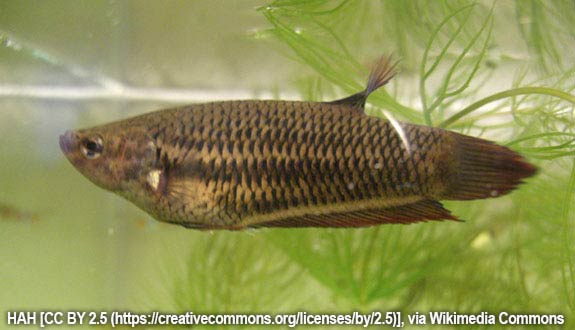
Today, the different shapes and colours offered to aquarists are the result of many years of patient selection. Thus, there are now many chromatic variants (red, blue, yellow, orange, white, black, purple, green, turquoise, pink, caramel ...) and very developed sails. Note that some varieties can reach 9 cm (3.5 inch). Here are some pictures for the pleasure of the eyes!
Crown orange
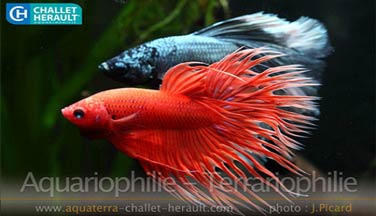
Double queue cooper
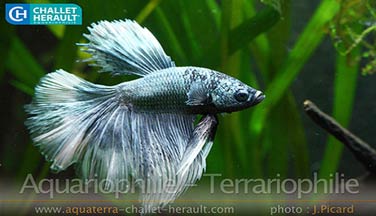
Halfmoon orange
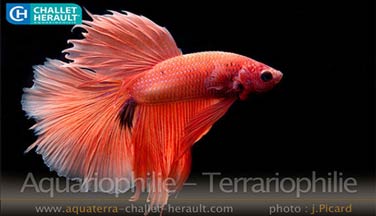
Koï
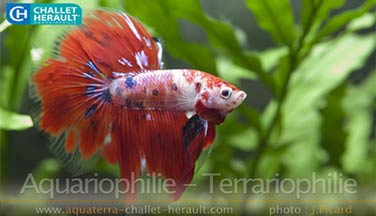
Lavender
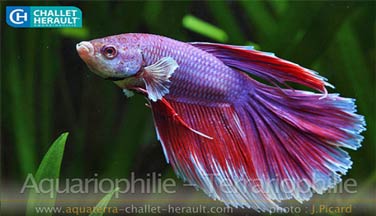
Mustard respiration
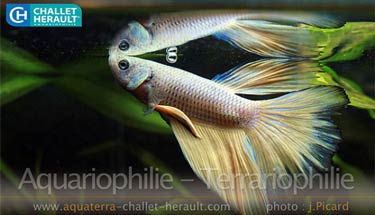
The Betta splendens are delineated in patterns and colours, which correspond to standard criteria. Find below an overview of the different patterns allowed:


Yours photos!
Comments
Sort by:
Please login to post comments
